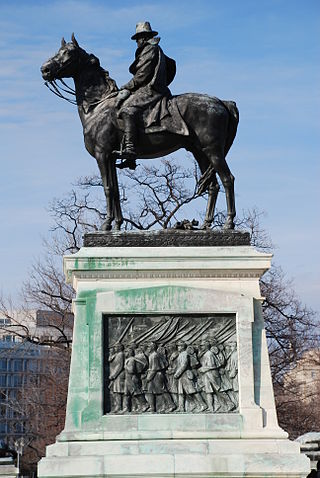
The Ulysses S. Grant Memorial is a presidential memorial in Washington, D.C., honoring American Civil War general and 18th president of the United States, Ulysses S. Grant. It sits at the base of Capitol Hill, below the west front of the United States Capitol. Its central sculpture of Grant on horseback faces west, overlooking the Capitol Reflecting Pool and facing toward the Lincoln Memorial, which honors Grant's wartime president, Abraham Lincoln. Grant's statue is raised on a pedestal decorated with bronze reliefs of the infantry; flanking pedestals hold statues of protective lions and bronze representations of the Union cavalry and artillery. The whole is connected with marble covered platforms, balustrades, and stairs. The Grant and Lincoln memorials define the eastern and western ends, respectively, of the National Mall.

Thomas Circle is a traffic circle in Northwest Washington, D.C., United States. It is located at the intersection of 14th Street, M Street, Massachusetts Avenue, and Vermont Avenue NW. A portion of Massachusetts Avenue travels through a tunnel underneath the circle. The interior of the circle includes the equestrian statue of George Henry Thomas, a Union Army general in the Civil War.
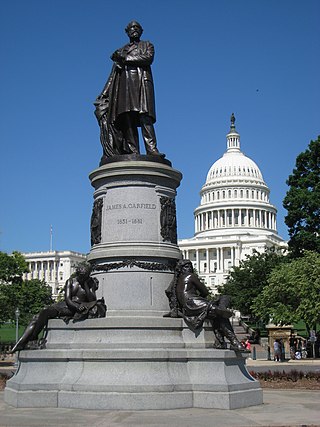
The James A. Garfield Monument stands on the grounds of the United States Capitol in Garfield Circle, a traffic circle at First Street and Maryland Avenue SW in Washington, D.C. It is a memorial to U.S. President James A. Garfield, who was elected in 1880 and assassinated in 1881 after serving only four months of his term. The perpetrator was an attorney and disgruntled office-seeker named Charles J. Guiteau. Garfield lived for several weeks after the shooting, but eventually succumbed to his injuries. The monument is part of a three-part sculptural group near the Capitol Reflecting Pool, including the Peace Monument and the Ulysses S. Grant Memorial in Union Square. The monument is also a contributing property to the National Mall and L'Enfant Plan, both of which are listed on the National Register of Historic Places and the District of Columbia Inventory of Historic Sites. The bronze statue rests on a granite pedestal that features three sculptures, each one representing a time period in Garfield's life.

Admiral David G. Farragut is a statue in Washington, D.C., honoring David Farragut, a career military officer who served as the first admiral in the United States Navy. The monument is sited in the center of Farragut Square, a city square in downtown Washington, D.C. The statue was sculpted by female artist Vinnie Ream, whose best-known works include a statue of Abraham Lincoln and several statues in the National Statuary Hall Collection. The monument was dedicated in 1881 in an extravagant ceremony attended by President James A. Garfield, members of his cabinet, and thousands of spectators. It was the first monument erected in Washington, D.C., in honor of a naval war hero.

Major General John A. Logan, also known as the General John A. Logan Monument and Logan Circle Monument, is an equestrian statue in Washington, D.C., that honors politician and Civil War general John A. Logan. The monument is sited in the center of Logan Circle, a traffic circle and public park in the Logan Circle neighborhood. The statue was sculpted by artist Franklin Simmons, whose other prominent works include the Peace Monument and statues in the National Statuary Hall Collection. The architect of the statue base was Richard Morris Hunt, designer of prominent buildings including the Metropolitan Museum of Art in New York City and The Breakers in Newport, Rhode Island. Prominent attendees at the dedication ceremony in 1901 included President William McKinley, members of his cabinet, Senator Chauncey Depew, Senator Shelby Moore Cullom, and General Grenville M. Dodge.

The Luther Monument is a public artwork located in front of Luther Place Memorial Church in Washington, D.C., United States. The monument to Martin Luther, the theologian and Protestant Reformer, is a bronze, full-length portrait. It is a copy of the statue created by Ernst Friedrich August Rietschel as part of the 1868 Luther Monument in Worms, Germany. The version in Washington, D.C., inspired the installation of many other castings across the U.S. The statue is a contributing property to the Luther Place Memorial Church's listing on the National Register of Historic Places (NRHP) and District of Columbia Inventory of Historic Sites (DCIHS). It is also a contributing property to the Greater Fourteenth Street Historic District, which is also listed on the NRHP and DCIHS.

Major General James B. McPherson is a public artwork by American artist Louis Rebisso, located at McPherson Square in Washington, D.C., United States. Major General James B. McPherson was originally surveyed as part of the Smithsonian's Save Outdoor Sculpture! survey in 1993. The monument is a bronze equestrian statue of Civil War hero James B. McPherson. The statue is a contributing monument to the Civil War Monuments in Washington, DC, of the National Register of Historic Places.

General Philip Sheridan is a bronze sculpture that honors Civil War general Philip Sheridan. The monument was sculpted by Gutzon Borglum, best known for his design of Mount Rushmore. Dedicated in 1908, dignitaries in attendance at the unveiling ceremony included President Theodore Roosevelt, members of the President's cabinet, high-ranking military officers and veterans from the Civil War and Spanish–American War. The equestrian statue is located in the center of Sheridan Circle in the Sheridan-Kalorama neighborhood of Washington, D.C. The bronze statue, surrounded by a plaza and park, is one of eighteen Civil War monuments in Washington, D.C., which were collectively listed on the National Register of Historic Places in 1978. The sculpture and surrounding park are owned and maintained by the National Park Service, a federal agency of the Interior Department.

The George Gordon Meade Memorial, also known as the Meade Memorial or Major General George Gordon Meade, is a public artwork in Washington, D.C. honoring George Meade, a career military officer from Pennsylvania who is best known for defeating General Robert E. Lee at the Battle of Gettysburg. The monument is sited on the 300 block of Pennsylvania Avenue NW in front of the E. Barrett Prettyman United States Courthouse. It was originally located at Union Square, but was removed and placed in storage for fourteen years before being installed at its current location. The statue was sculpted by Charles Grafly, an educator and founder of the National Sculpture Society, and was a gift from the state of Pennsylvania. Prominent attendees at the dedication ceremony in 1927 included President Calvin Coolidge, Governor John Stuchell Fisher, Secretary of the Treasury Andrew W. Mellon, and Senator Simeon D. Fess.

Lieutenant General George Washington is an 1860 equestrian statue of George Washington, at Washington Circle, at the edge of the George Washington University's campus, in Washington, D.C. The statue was sculpted by Clark Mills, who also created the equestrian statue of Andrew Jackson in front of the White House. The traffic circle where the statue is located was one of the original city designs by Pierre Charles L'Enfant. The statue and surrounding park are in the Foggy Bottom neighborhood at the intersection of 23rd Street, New Hampshire Avenue, and Pennsylvania Avenue NW. The K Street NW underpass runs beneath the circle.
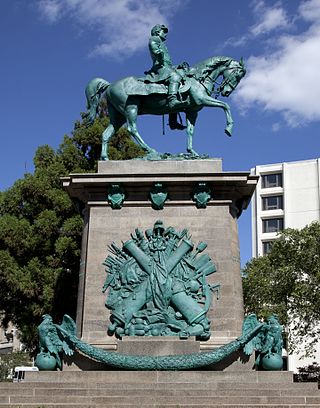
Major General George B. McClellan is an equestrian statue in Washington, D.C. that honors politician and Civil War general George B. McClellan. The monument is sited on a prominent location in the Kalorama Triangle neighborhood due to efforts made by area residents. The statue was sculpted by American artist Frederick William MacMonnies, a graduate of the École des Beaux-Arts whose best known work is a statue of Nathan Hale in New York City. MacMonnies was chosen to design the statue following a lengthy competition organized by a statue commission, led by then Secretary of War William Howard Taft. The monument was dedicated in 1907, with prominent attendees at the ceremony including President Theodore Roosevelt, New York City mayor George B. McClellan Jr., politicians, generals and thousands of military personnel.

Brevet Lt. General Winfield Scott is an equestrian statue in Washington, D.C., that honors career military officer Winfield Scott. The monument stands in the center of Scott Circle, a traffic circle and small park at the convergence of 16th Street, Massachusetts Avenue and Rhode Island Avenue NW. The statue was sculpted by Henry Kirke Brown, whose best-known works include statues of George Washington in New York and Nathanael Greene in Washington, D.C. It was the first of many sculptures honoring Civil War generals that were installed in Washington, D.C.'s traffic circles and squares and was the second statue in the city to honor Scott.

The Dupont Circle Fountain, formally known as the Rear Admiral Samuel Francis Dupont Memorial Fountain, is a fountain located in the center of Dupont Circle in Washington, D.C. It honors Rear Admiral Samuel Francis Du Pont, a prominent American naval officer and member of the Du Pont family. The fountain replaced a statue of Du Pont that was installed in 1884. Designed by Henry Bacon and sculpted by Daniel Chester French, the fountain was dedicated in 1921. Prominent guests at the dedication ceremony included First Lady Florence Harding, Secretary of War John W. Weeks and Secretary of the Navy Edwin Denby.

The General William Tecumseh Sherman Monument is an equestrian statue of American Civil War Major General William Tecumseh Sherman located in Sherman Plaza, which is part of President's Park in Washington, D.C., in the United States. The selection of an artist in 1896 to design the monument was highly controversial. During the monument's design phase, artist Carl Rohl-Smith died, and his memorial was finished by a number of other sculptors. The Sherman statue was unveiled in 1903. It is a contributing property to the Civil War Monuments in Washington, D.C. and to the President's Park South, both of which are historic sites listed on the National Register of Historic Places.
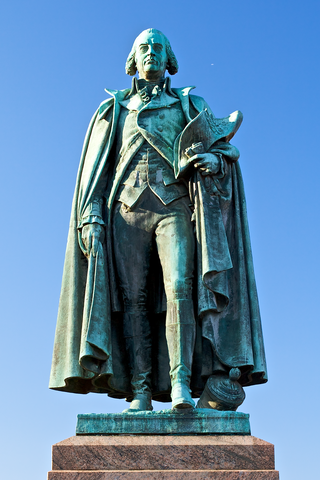
General Artemas Ward is a bronze statue of American Revolutionary War general Artemas Ward. It is sited in the center of Ward Circle, which was specifically made for the statue, at the intersection of Nebraska and Massachusetts Avenue in the American University Park neighborhood of Washington, D.C. The 10-foot (3.0 m) statue of Ward was completed in 1936, but was not unveiled for two years. Ward was the first Commander-in-Chief of colonial forces during the Revolutionary War and served in a number of government roles, including as representative to the United States House of Representatives.

The statue of John Aaron Rawlins, a United States Army general who served during the Civil War and later as Secretary of War, is a focal point of Rawlins Park, a small public park in Washington, D.C.'s Foggy Bottom neighborhood. It was installed in 1874, but relocated several times between 1880 and 1931. The statue was sculpted by French-American artist Joseph A. Bailly, whose best known work is the statue of George Washington in front of Independence Hall in Philadelphia.

Major General Nathanael Greene is a bronze equestrian statue honoring Nathanael Greene, a military leader during the American Revolutionary War. Greene was from modern-day Rhode Island and after laws passed by the Kingdom of Great Britain, along with the burning of one of his ships, Greene formed a state militia. He was later promoted to brigadier general in the Continental Army where he became a trusted adviser to Commander-in-Chief General George Washington. Greene played an active role during the war, participating in battles, sieges, and campaigns from New England to the Southern Colonies. For his service to the war, Greene was offered free land and settled in Georgia with his family. He died a few years later from a heatstroke.

American Revolution Statuary is a group of fourteen statues in Washington, D.C., that honor men whose actions assisted the Thirteen Colonies in their fight against the Kingdom of Great Britain in the American Revolutionary War. They are spread throughout the city, except for the four statues in Lafayette Square, across from the White House, that honor some of the foreign heroes from the war. Some of the statues are located in prominent places, while others are in small parks or stand alone in front of buildings. All of the statues are owned and maintained by the National Park Service, an agency of the United States Department of the Interior. The statuary was collectively listed on the National Register of Historic Places (NRHP) in 1978 and the District of Columbia Inventory of Historic Sites the following year. In addition, most are also contributing properties to historic districts listed on the NRHP.

General Winfield Scott Hancock is an equestrian statue of Winfield Scott Hancock, by Henry Jackson Ellicott together with architect Paul J. Pelz. It is located at Pennsylvania Avenue in United States Navy Memorial Park at the northwest corner of 7th Street, Northwest, Washington, D.C.
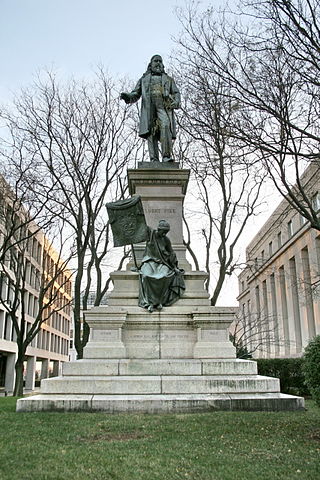
The Albert Pike Memorial is a public artwork in Washington, D.C., erected in 1901, and partially demolished in 2020 by protestors responding to the murder of George Floyd. It honors Albert Pike (1809–1891), a senior officer of the Confederate States Army as well as a poet, lawyer, and influential figure in the Scottish Rite of freemasonry. The memorial—which now only includes the base and Goddess of Masonry sculpture—sits near the corner of 3rd and D Streets NW in the Judiciary Square neighborhood. The memorial's two bronze figures were sculpted by Gaetano Trentanove, the Italian-American sculptor of another Washington, D.C., sculptural landmark, the Daniel Webster Memorial. The dedication ceremony in 1901 was attended by thousands of Masons who marched in a celebratory parade.
























